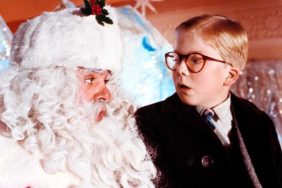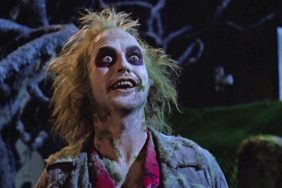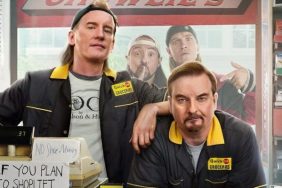Cats. You love ’em, we love ’em, Hollywood seems a teensy bit ambivalent. Because for every decent cat movie out there, there seems to be a few dozen movies in which a dog is either a gallant hero or a badass villain. Down with dogs! Up with cats! In the middle with rodents! But we digress…
Keanu is, if nothing else, a damn good cat movie. It’s a film about the absurd lengths to which people will go for the sake of their cat, in which comedians Keegan-Michael Key and Jordan Peele are forced to impersonate deadly drug cartel assassins in order to save their kitten, “Keanu,” from the clutches of a dangerous gang. Maybe – just maybe – it’s one of the best cat movies ever made. But what is THE best cat movie ever made?
Also: Kitten Around with Key and Peele (Exclusive Sleepy Kitten Video!)
As usual, we asked our panel of film critics – Crave’s William Bibbiani and Witney Seibold, and Collider’s Brian Formo – to each make their case for just one movie. And as usual they came at the topic from different directions, selecting a Japanese horror movie, a classic film noir and a wholly irresponsible wildlife thriller as their prime examples of cat movies at their best.
Find out what they picked and why, and come back every Wednesday for all-new, highly debatable installments of Crave’s The Best Movie Ever!
Witney Seibold’s Pick: Kuroneko (1968)

Kindai Eiga Kyokai
Cats, cinematically, often get the short end of the stick. In films, cats are most often depicted as aloof at best, and sinister at worst. Cats are most frequently seen as inscrutable, evil schemers who will show you affection for as long as it takes them to eat you alive. Dogs, meanwhile, are the loving, adorable carriers of halcyon childhood memories. Oh sure, you have attack dog movies like Cujo and Man’s Best Friend, but those are meant to be topsy-turvy inversions of what we feel about dogs. Cats, meanwhile, get movies like Cat People, Sleepwalkers, The Black Cat, Tales from the Darkside: The Movie, Cat’s Eye, Cats & Dogs, Cinderella, Babe, and so many other depictions of their outright untrustworthiness. If a cat is to be friendly, then they can’t be portrayed by an actual cat. They have to be animated (I’m very fond of an obscure animated film called Cats Don’t Dance).
But as long as that villainy proves to be a constant, we may as well acknowledge the best of that trend. The scariest cat-related film I have seen is probably Kaneto Shindo’s 1968 horror film Kuroneko, a dark and moody ghost story set around the Rashomon gate, made famous to American audiences by Akira Kurosawa’s 1950 film. In Kuroneko, a pair of Japanese women are raped and murdered in a bamboo grove by a passing bandit. A cat witnesses. When they are dead, the cat somehow falls into a ghostly kinship with their spirits, allowing the women to return as vengeful spirits who lure passing samurai back to a ghost mansion where they are torn apart as if from cats. Complication arise when a passing samurai, questing to destroy the spirits, turns out to be the husband of one of the women, and son of the other.
Shindo, a prolific Japanese director, also directed Onibaba, one of the best films of the 1960s, is a master of atmosphere and slow dread. Kuroneko takes place in a dimmed world of whispering plants and supernatural vengeance. The wrath of the ghostly cat women has become a part of the landscape, and may serve as a cultural vengeance for all women wronged by men. But, despite the horrors of the movie, there is still a note of tempting compassion lurking under everything. It’s scary, yes, but also very, very sad.
Brian Formo’s Pick: The Long Goodbye (1973)

United Artists
Before I get into a gushy discussion of Robert Altman’s The Long Goodbye, lemme just say that Elliott Gould (who plays Raymond Chandler’s most iconic character, private detective Phillip Marlowe) fully sees the cat as integral to the picture, despite a limited appearance. On the DVD featurette “Rip Von Marlowe” Gould says that he sees the point of the film as being that people are as fickle as a cat. Now, I don’t see cats as fickle, just that you do have to consistently show them that you love them but also respect their space. I respect that.
The Long Goodbye opens with a glorious tracking shot of Marlowe getting some shut eye, being awoken by his hungry cat, and going to the kitchen to feed it. The rascal looks at his bowl of food, and—totally unsatisfied—continues to meow to let him know that he’s not actually interested in that same old shit (spice it up, my man!). Marlowe exits his apartment to go to the supermarket for some new cat food, and he encounters nude yoga neighbors on their balcony who want some brownie mix from the grocery store, too. Marlowe slumbers past both cat and woman, but heeds their requests. At the store, they don’t have the brand his discerning kitty likes and the nearest employee tells Marlowe that all the cat food tastes the same. Marlowe’s response, “You don’t have a cat.” The shopkeep’s response? “What do I need a cat for? I got a girl.” Marlowe mumbles, “He’s got a girl, I got a cat.”
The cat is our introduction to Marlowe. It wakes him from his dream. Altman says the dream was of Chandler’s tough guy noir and the film business of yore. This Marlowe wakes up 30 years later, in a bizarre spot where lounging beauties are now active yoga beauties who can be independent of men. Where birds don’t dictate things, cats do. And where people want lesser things from a detective: not, get me some pictures of a cheating husband, but get me some brownie mix, and some goddamn delicious cat food!
William Bibbiani’s Pick: Roar (1981)

Drafthouse Films
There are a lot of cat movies that I like – The Adventures of Milo and Otis, The Three Lives of Thomasina, Cat People, Cat’s Eye – but only one that I think my cat would actually like. The 1981 thriller Roar is one of the most terrifying films ever produced, and not for the reasons I think the filmmakers intended. The films stars real-life spouses Tippi Hedren (who previously had a problem with The Birds) and Noel Marshall (who wrote and directed), and it takes place at a wild cat preserve where the people freely mingle with over one hundred jungle cats, most of whom have not been tamed and who sometimes attack the actors in the middle of a scene for no reason other than they are giant murder monsters.
Noel Marshall has to leave the preserve at the beginning of the film, not knowing that his family (including real-life daughter Melanie Griffith, who was mauled during the production – yes, really) was arriving early, and headed straight for a confrontation with free-roaming predator demons. What follows is hard to explain, not because it’s confusing – the hapless family is assaulted by lions, in real life and on-screen – but rather because it’s hard to tell whether Roar thinks the incident is funny or frightening. Are we supposed to be amused that these ignoramuses don’t know that the cats are only playing, or are we supposed to be horrified that these furry carnivores are about to kill all these fleshy meatbags without even trying hard?
Roar took 11 years to produce, for a variety of reasons. Melanie Griffith almost lost an eye, and all told over 70 crew members were injured on the set, including future Speed director Jan De Bont who, in his position as cinematographer, was scalped by a lion and then proceeded to return to work after he receiving 220 stitches. There is no other film that so disturbingly captures mankind’s collective obsession with cats. We insist to all the world that they are the cutest little things, but they don’t care if we live or die so long as the food flows freely, and wouldn’t you know it? We are all made up of food.
Previously on The Best Movie Ever:
Top Photos: Drafthouse Films / United Artists / Kindai Eiga Kyokai
The Best Movie Ever
-
The Best Movie Ever | Under the Sea

Is the best movie ever set underwater a family film about a fish or a World War II movie about a German submarine?
Photos: Disney / Pixar / Neue Constantin Film
-
The Best Movie Ever | Video Game Adaptations

There aren't a lot of good video game adaptations, and our critics just can't agree on which one is the best.
Photos: Universal Pictures / New Line Cinema / Dimension Films
-
The Best Movie Ever | Reptiles

Movies about slithery things aren't very common, so our critics are presenting their picks for the best reptile movies ever.
Photo: Warner Bros. / Paramount Pictures / New Line Cinema
-
The Best Movie Ever | Helena Bonham Carter

Is Helena Bonham Carter's best movie a classy costume drama or a twisted critique of contemporary masculinity?
Photo: Fine Line Features / Miramax Films / 20th Century Fox
-
The Best Movie Ever | Crime Comedies

What's the best comedy ever made about living a life of crime? Our critics present their picks.
Photo: MGM / Warner Bros. / Janus Films
-
The Best Movie Ever | Jodie Foster

The Oscar-winning actor/director is one of the most respected artists in the film industry. But what's her best movie ever?
Photo: Columbia Pictures / Warner Bros. / MGM Home Entertainment
-
The Best Movie Ever | Robert Downey Jr.

The man who would be Iron Man has had one of the most unusual careers in film history, but which movie is his best?
Photo: Warner Bros. Pictures / Paramount Pictures
-
The Best Movie Ever | Cats

Keanu may be a great comedy about a cat, but what's the best cat movie ever? Our critics picked some WEIRD films this week!
Photo: Drafthouse Films / United Artists / Kindai Eiga Kyokai
-
The Best Movie Ever | Charlize Theron

Is Charlize Theron's best movie the one that earned her an Oscar, or the one that kicked ass?
Photo: Warner Bros. / Newmarket Films
-
The Best Movie Ever | Ice Cube

It's been 25 years since Ice Cube made his acting debut. So what's his best movie ever?
Photo: Miramax Films / New Line Cinema / Universal Pictures
-
The Best Movie Ever | Dreams

What's the best movie ever made about dreams, dreaming or dreaminess? Our critics present their picks.
Photo: Films du Losange / Criterion / Fox Searchlight
-
The Best Movie Ever | Batman

Everybody loves Batman, but what's the best Batman movie ever? Our critics can't agree in this week's roundup.
Photo: 20th Century Fox / Warner Bros.
-
The Best Movie Ever | Superman

Batman v Superman isn't the best Superman movie ever, so we asked our stable of critics to decide which one is.
Photo: Warner Bros.
-
The Best Movie Ever | Justice

Let's celebrate this exciting new Dawn of Justice with a spirited debate about the best movie ever made about justice itself.
Photo: Koch-Lorber / 20th Century Fox / United Artists
-
The Best Movie Ever | John Goodman

The star of 10 Cloverfield Lane has had an astounding career, but what's his best movie ever?
Photo: Gramercy Pictures / 20th Century Fox
-
The Best Movie Ever | Die Hard Ripoffs

Die Hard spawned a whole genre of action movies that live on to this day, but which Die Hard ripoff is the best?
Photo: 20th Century Fox / Columbia Pictures / Golden Princess Film Production
-
The Best Movie Ever | Oscar Bait

'Oscar bait' isn't an insult, it's a genre. So what's the best Oscar bait movie ever?
Photo: The Weinstein Company / Universal Pictures
-
The Best Movie Ever | Witchcraft

What's the most bewitching movie ever made about witches? Our panel of critics narrows it down to two classic films.
Photo: Criterion / American International
-
The Best Movie Ever | Action Comedies

If Deadpool isn't the best action comedy ever, what is? Our panel of film critics make the case for their favorites.
Top Photo: Warner Bros. / RM Films International / 20th Century Fox
-
The Best Movie Ever | George Clooney

Everyone loves George Clooney, but none of our critics can agree on which film qualifies as his very best.
Photo: Buena Vista / Universal / Warner Bros.
-
The Best Movie Ever | Martial Arts

Our panel of critics fights over their picks for the best martial arts movie ever made. There can be only one!
Top Photo: Shaw Bros. / Warner Bros. / Toho
-
The Best Movie Ever | Creepy Dolls

Everyone's frightened of little toy people, but what's the creepiest creepy doll movie ever?
Top Photo: Universal Pictures / United Artists / New World Pictures
-
The Best Movie Ever | Modern Warfare

If 13 Hours isn't the best movie about our contemporary wars, what is? Our panel of critics weighs in.
Photo: Warner Bros./Columbia Pictures/Summit Entertainment
-
The Best Movie Ever | Revenge

If The Revenant isn't the greatest revenge movie, what is? Our film critics nominate some of the best films ever made.
Top Photos: Janus Films / Paramount Pictures / Tartan Films
-
The Best Movie Ever | Parties

We asked our critics to pick the best party movie ever made, and none of them picked a film about a frat house.
Photo: Warner Bros. / 20th Century Fox / Sony Pictures Classics
-
The Best Movie Ever | Quentin Tarantino

Is the Hateful Eight director's best film an autumnal romance or a World War II drama? Our critics can't decide.
Photos: The Weinstein Company / Miramax
-
The Best Movie Ever | Star Wars

Is A New Hope better than The Empire Strikes Back? Our critics debate the classics (and ignore the rest).
Photos: Disney / LucasFilm
-
The Best Movie Ever | Ron Howard

He's directed films in nearly every genre and won an Oscar for his troubles, but what's the best Ron Howard movie ever?
Photo: Touchstone / Universal / MGM
-
The Best Movie Ever | William Shakespeare

He's the most adapted author in movie history, but which William Shakespeare movie is the very best?
Photo: Top Photos: Toho / Paramount / Columbia
-
The Best Movie Ever | Pixar

Everyone has their favorite Pixar movie, but which one is the best?
Photo: Disney
-
The Best Movie Ever | Young Adult

Before you say goodbye to The Hunger Games, find out what our critics think was the best young adult movie ever.
Photo: Universal Pictures / Warner Bros.
-
The Best Movie Ever | Angelina Jolie

She's been acting for decades, directing for years, and winning our admiration forever. But what is Angelina Jolie's best film ever?
Photo: The Samuel Goldwyn Company / HBO / Columbia Pictures
-
The Best Movie Ever | James Bond

It's new school versus old school! Our critics debate which film qualifies as the best Bond movie ever.
Photo: MGM / Colombia Pictures / United Artists
-
The Best Movie Ever | Sandra Bullock

Our critics can only agree on one thing: the best Sandra Bullock movie isn't the one that got her an Oscar.
Photo: 20th Century Fox / Warner Bros.








